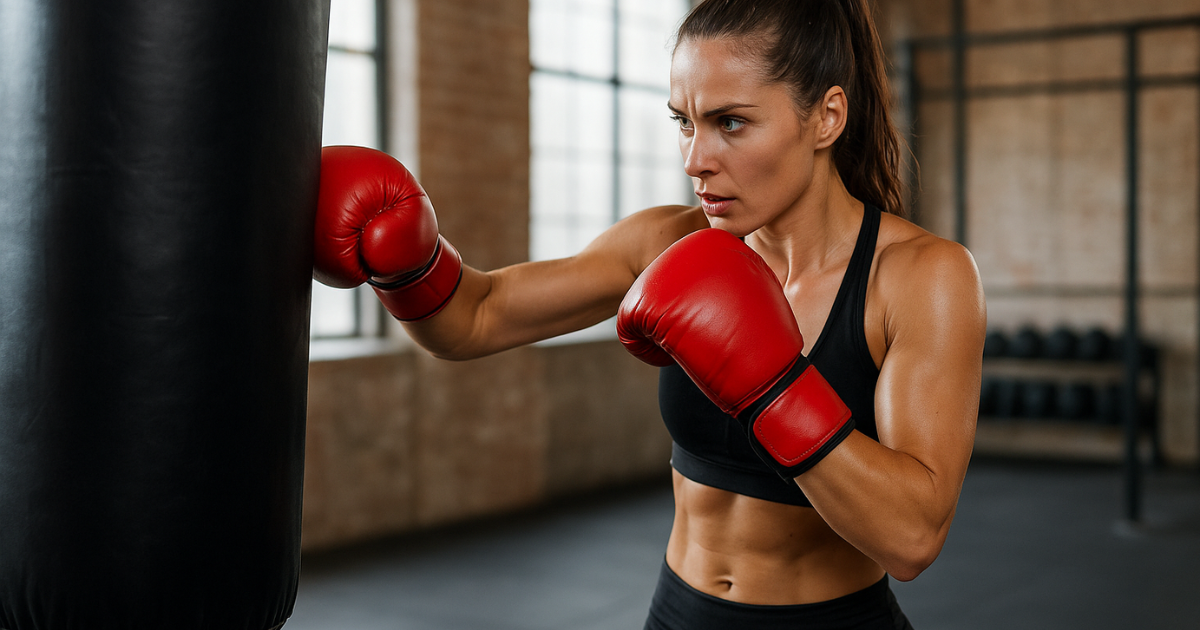Introduction: Why Boxing is the Ultimate Fat-Burning Workout
When it comes to shedding pounds, many people turn to running, cycling, or gym classes. While these are effective, boxing takes fat burning to another level. It’s not just a workout—it’s a high-energy, full-body experience that torches calories, builds lean muscle, and improves mental toughness. With each punch, jab, and hook, you’re working your arms, shoulders, core, legs, and cardiovascular system all at once.
Boxing is also fun and engaging, which makes it easier to stick to compared to repetitive cardio routines. Whether you’re hitting the heavy bag, working with a trainer, or shadowboxing at home, the variety keeps your body guessing—and burning more fat in the process.
The Science Behind Boxing and Weight Loss
How Boxing Burns Calories Efficiently
Boxing is an explosive sport. It combines fast movements with bursts of power, which requires significant energy. A 1-hour boxing session can burn anywhere between 600–1,000 calories, depending on intensity and body weight. That’s nearly double what you’d burn jogging at a steady pace.
The Role of High-Intensity Interval Training (HIIT) in Boxing
Most boxing workouts follow a HIIT structure: short rounds of maximum effort followed by brief rest. This style boosts your metabolism and keeps you burning calories long after the workout ends—a phenomenon known as the afterburn effect (EPOC).
Boxing vs. Traditional Cardio for Fat Loss
While steady-state cardio (like running or cycling) builds endurance, boxing provides both aerobic and anaerobic training. This means you not only improve stamina but also build explosive power, making it a more efficient fat-loss method compared to long, monotonous cardio sessions.
Key Benefits of Boxing for Weight Management
Full-Body Workout that Engages Multiple Muscle Groups
Boxing isn’t just about throwing punches. Footwork, head movement, and body rotation all engage your legs, core, shoulders, and back muscles, giving you a complete workout in a single session.
Improved Cardiovascular Health
Every time you spar or hit the bag, your heart rate climbs into fat-burning zones. Over time, this improves heart health, lowers cholesterol, and helps regulate blood pressure.
Stress Reduction and Mental Wellness
Boxing is a powerful stress reliever. Hitting a heavy bag releases pent-up frustration and triggers the release of endorphins, the “feel-good hormones.” This reduces cortisol (the stress hormone), which is often linked to weight gain.
Boxing Techniques that Maximize Fat Burn
Shadow Boxing
A great warm-up and conditioning drill, shadow boxing boosts coordination, speed, and endurance.
Heavy Bag Workouts
Smashing the heavy bag builds explosive power while torching calories. It also strengthens your core, arms, and legs.
Pad Work with a Trainer
Working with mitts improves accuracy, speed, and reaction time while keeping your heart rate high.
Jump Rope and Footwork Drills
Jump rope is a boxing staple—it develops footwork, agility, and cardiovascular endurance, making it perfect for fat loss.
Structuring a Boxing Workout for Weight Loss
Warm-Up and Mobility Exercises
Every effective boxing session begins with a proper warm-up. This primes your muscles, lubricates your joints, and reduces the risk of injury. A typical warm-up may include:
- Dynamic stretches (arm circles, hip rotations)
- Jump rope (3–5 minutes)
- Light shadow boxing to activate your muscles
Warming up increases blood flow and prepares your body for the intense workout ahead.
Rounds, Rest, and Intensity Levels
Boxing workouts usually follow the round system, mimicking real boxing matches. A beginner-friendly format looks like this:
- 3 minutes of work (punch combinations, heavy bag, or pad work)
- 1 minute of rest
- Repeat for 6–10 rounds
The key to fat loss is intensity. During each round, give maximum effort—throw punches, move your feet, and engage your core.
Cool Down and Recovery Tips
After the workout, it’s crucial to cool down properly. Spend 5–10 minutes stretching your shoulders, hips, and hamstrings. Deep breathing and static stretches help lower your heart rate, reduce muscle soreness, and speed up recovery.
Nutrition Tips to Support Boxing and Fat Loss
Pre-Workout Fuel
Boxing demands energy, so fuel up with light carbs and protein:
- A banana with peanut butter
- Oatmeal with berries
- Greek yogurt with honey
Post-Workout Recovery Meals
After intense training, your muscles crave protein for repair and carbs for glycogen replenishment. Examples include:
- Grilled chicken with quinoa and vegetables
- Salmon with sweet potato
- Protein shake with almond milk and fruit
Hydration and Electrolytes
Boxing makes you sweat—a lot. Replenish fluids with water, coconut water, or electrolyte drinks to avoid dehydration and fatigue.
Common Mistakes to Avoid When Using Boxing for Weight Loss
Overtraining Without Proper Recovery
Boxing is demanding. Training too frequently without rest can lead to burnout, fatigue, and injuries. Aim for 3–4 sessions per week with rest days in between.
Ignoring Strength Training and Mobility Work
While boxing is fantastic for fat loss, pairing it with strength training helps you build lean muscle, which boosts metabolism. Flexibility and mobility drills also prevent injuries.
Poor Nutrition Choices
No matter how much you train, poor eating habits can sabotage results. Avoid sugary snacks, processed foods, and excessive alcohol if your goal is fat loss.
Success Stories: Real People Who Lost Weight with Boxing
Many individuals have transformed their lives through boxing. For example:
- Sarah, a 32-year-old, lost 25 pounds in 6 months by combining boxing with a healthy diet.
- David, 40, struggled with running due to knee pain but dropped 30 pounds in 4 months through low-impact boxing drills.
- Michelle, 27, not only lost 15 pounds but also gained confidence and reduced stress by training with a boxing coach.
These success stories prove that boxing is not just for fighters—it’s for anyone who wants to torch fat and tone up.
FAQs on Boxing for Weight Loss
How often should I box to lose weight?
For effective fat loss, 3–4 sessions per week is ideal. Beginners can start with 2 sessions and gradually increase.
Is boxing good for beginners trying to get fit?
Absolutely! Boxing can be scaled to any fitness level. You don’t need to spar—you can start with shadow boxing and heavy bag workouts.
Can boxing help me lose belly fat specifically?
Boxing helps burn overall body fat. While you can’t target just belly fat, reducing total fat percentage will slim your waistline.
Do I need equipment to start boxing workouts?
Not necessarily. You can start with shadow boxing at home. However, gloves, hand wraps, and a heavy bag enhance your training.
How many calories can I burn in a 1-hour boxing session?
Depending on your weight and intensity, you can burn 600–1,000 calories per hour.
Is boxing better than running for fat loss?
Boxing burns more calories in less time and also builds muscle, making it more effective for fat loss than steady-state running.
Conclusion: Knock Out Fat and Build a Lean Body with Boxing
Boxing is more than just a sport—it’s one of the most effective fat-burning workouts available. It combines strength, cardio, agility, and mental focus into one powerful training method. With the right structure, nutrition, and consistency, you can burn fat, tone your muscles, and boost your confidence.
Whether you’re a beginner or fitness enthusiast, boxing can help you reach your weight-loss goals faster while keeping workouts fun and engaging. Put on those gloves, step into the ring (or your living room), and start punching your way to a leaner, stronger you!

